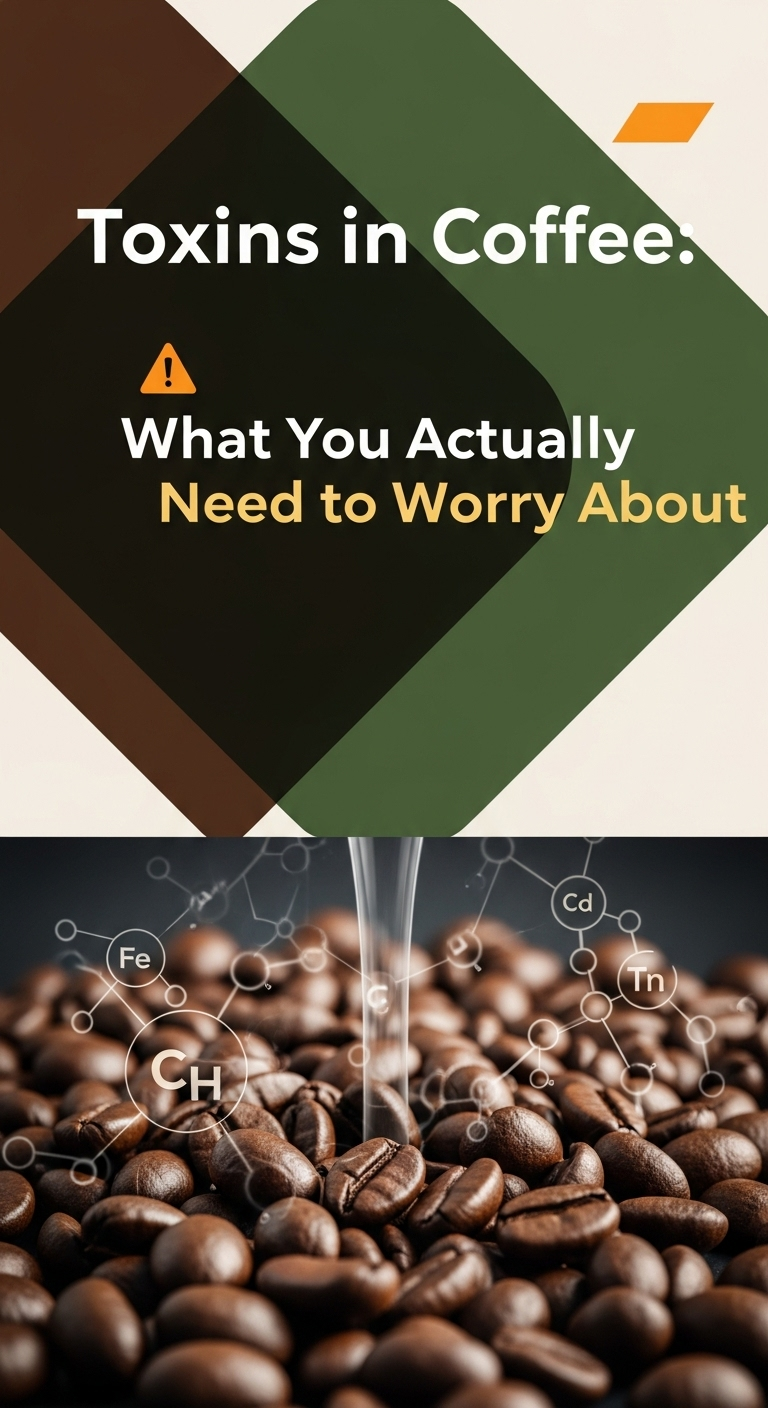As an Amazon Associate CoffeeXplore.com earns from qualifying purchases.
Toxins in Coffee: What You Actually Need to Worry About
That nagging question at the back of your mind as you pour your morning brew—”Am I drinking something harmful?”—is more common than you think. You’ve heard whispers about mold, pesticides, and other harmful chemicals in coffee, and you want to know if there are genuine toxins in coffee you should worry about.
Yes, coffee can contain trace amounts of toxins like mycotoxins and pesticide residues, but the levels in commercial coffee are rigorously controlled and processed to be well below safety limits, posing minimal risk to the average person.
Leveraging extensive analysis of available data and established industry practices, this guide unpacks the science behind toxins in coffee. We’ll explore what these contaminants are, how they get there, and most importantly, how modern processing makes your daily cup overwhelmingly safe. We will break down exactly what you need to know to enjoy your coffee with confidence.
Key Facts
- Roasting is a powerful detoxifier: High-temperature roasting is incredibly effective at eliminating contaminants. Studies show it can reduce levels of Ochratoxin A, a common mycotoxin, by a remarkable 69–96%.
- Processing drastically reduces pesticides: While pesticides are used in conventional farming, the combination of washing, roasting, and brewing is highly effective at removal. Research on the pesticide dinotefuran found that brewing alone can reduce its concentration in the final liquid by 92.9–100%.
- Acrylamide isn’t unique to coffee: The roasting process does create acrylamide, a potential carcinogen. However, it’s found in most roasted foods, particularly starchy ones like potato chips and toast, and levels in coffee are not considered a significant health risk.
- Decaf may have slightly more mycotoxins: Caffeine is a natural defense mechanism for the coffee plant that inhibits mold growth. Its removal during decaffeination can lead to slightly higher mycotoxin levels, though still well below safety thresholds.
- Regulation provides a safety net: The levels of potential toxins in commercially sold coffee are monitored and typically fall far below the safety limits established by international regulatory bodies, ensuring a safe product for consumers.
The Core Question: Are There Harmful Toxins in Your Coffee?
Let’s tackle the main concern head-on. The simple answer is yes, trace amounts of potentially harmful chemicals in coffee can exist. However, the context is crucial. The presence of a substance doesn’t automatically equal a health risk. For the vast majority of coffee drinkers, the levels of these compounds are so low they are considered insignificant. The journey from a coffee cherry on a farm to the brew in your mug involves multiple stages of processing specifically designed to clean and purify the final product. But what does ‘trace amounts’ really mean for your daily cup? Let’s break it down.

The main toxins in coffee that researchers and consumers focus on fall into a few key categories:
* Mycotoxins: These are compounds produced by mold that can grow on coffee beans if they are not dried or stored correctly.
* Pesticides: These are chemical residues from conventional farming practices used to protect crops.
* Other Contaminants: This includes compounds that can be introduced during processing (like acrylamide) or from environmental sources (like heavy metals or PFAS).
The good news? As you’ll see, the coffee industry has robust, science-backed methods to ensure these potential toxins in coffee are reduced to minimal and safe levels before they ever reach you.
Understanding Mycotoxins in Coffee: The Mold Myth Debunked
The idea of mold in coffee is one of the biggest sources of concern about whether there are toxins in coffee. Mycotoxins are toxic compounds produced by certain types of mold (fungi), like Aspergillus and Penicillium, that can grow on agricultural crops, including coffee beans. While this sounds alarming, the risk is exceptionally low for the average coffee drinker. One study found Ochratoxin A (OTA) in just 18% of commercially available coffee brews, and even then, at very low levels. Roasting alone can reduce OTA levels by an incredible 69–96%.
Here are the two primary mycotoxins of concern:
| Mycotoxin | Produced By | Potential Concern |
|---|---|---|
| Aflatoxin B1 (AFB1) | Aspergillus mold | Known carcinogen |
| Ochratoxin A (OTA) | Aspergillus & Penicillium molds | Weak carcinogen, potentially harmful to kidneys |
Quick Fact: Your liver is actually well-equipped to neutralize the trace amounts of mycotoxins you encounter daily from many common foods, not just coffee! They are also found in grains, raisins, beer, and peanut butter, so complete avoidance is impossible, but managing exposure is key.
How Coffee Processing Drastically Reduces Mycotoxin Risk
The main reason mycotoxins in coffee are a minimal concern is due to modern quality control and processing. Far from being a widespread problem, it’s an issue the industry actively and effectively manages.
Here are the key steps that protect your brew:
- Wet Processing: This method, where the coffee fruit (cherry) is washed and fermented in water before drying, is highly effective at removing molds and the mycotoxins they produce. It’s a first line of defense that cleans the beans thoroughly.
- High-Temperature Roasting: This is the most critical step. Roasting coffee beans at temperatures around 200°C (392°F) is destructive to mycotoxins. Studies confirm that this process alone can destroy up to 96% of Ochratoxin A and 42–55% of Aflatoxin.
- Strict Quality Control: Reputable coffee producers sort and discard defective or moldy beans before they ever enter the supply chain, further ensuring the purity of the final product.
Pro Tip: This is why the quality of processing matters just as much as the origin of the bean when it comes to coffee purity.
Pesticide Residues in Coffee: What You Need to Know
Conventional coffee farming often relies on pesticides and herbicides to protect crops from pests and disease. This raises the question of whether these harmful chemicals in coffee make their way into your final cup. While residues can be present on green coffee beans, the story doesn’t end there.
Common pesticides used in coffee cultivation can include:
* Glyphosate
* Endosulfan
* Chlorpyrifos
* Imidacloprid
The key safeguard here is regulation and processing. Many countries enforce Maximum Residue Levels (MRLs), which set legal limits for how much pesticide residue is allowed in food products.
Furthermore, the same processes that protect against mycotoxins also reduce pesticide levels. Research has shown that washing, roasting, and brewing all contribute to a cleaner cup. For example, studies on the pesticide dinotefuran showed that washing raw beans reduced concentrations by up to 86.7%, and roasting further reduced them by up to 100%. Brewing is often the final, most effective step, eliminating the vast majority of what little might remain.
With all this processing, how much pesticide residue actually makes it into your cup? The answer is generally very little, far below levels that would pose a health risk.

Other Potential Contaminants to Be Aware Of
Beyond mold and pesticides, modern research is investigating other potential toxins in coffee. While these are emerging areas of study, it’s important to have a complete picture.
- PFAS “Forever Chemicals”: Recent research has found a link between high coffee consumption and higher levels of PFAS in the blood. These chemicals can enter the coffee supply through contaminated water sources used for growing or from certain types of packaging.
- Microplastics: Worried about your coffee pods? This might make you reconsider what kind you buy. Some plastic pods have been found to contain endocrine disruptors like BPS and BPF, and they may contribute to microplastic ingestion.
- Acrylamide: This compound is not added to coffee but is naturally formed during the high-temperature roasting process when sugars and amino acids react. It is a known potential carcinogen, but it’s also found in french fries, potato chips, and even toast. The levels in coffee are not considered a major health concern.
- Heavy Metals: Trace amounts of heavy metals like lead and cadmium can be found in coffee, absorbed from the soil the plants grow in. However, data shows these levels are typically very low and fall well within the safety limits established by organizations like the FDA and World Health Organisation (WHO).

How to Choose a Cleaner, Toxin-Minimized Coffee
While standard commercial coffee is overwhelmingly safe, concerned consumers can take extra steps to ensure they are drinking the purest coffee possible. If you want to proactively minimize your exposure to any potential toxins in coffee, here is a clear guide to making smarter choices.
- Choose Certified Organic: This is the most effective step to avoid synthetic pesticide and herbicide residues. To be certified, coffee must be grown without these chemicals. Pro Tip: Look for labels! Certifications like ‘USDA Organic’ aren’t just marketing—they represent a specific set of farming and processing standards.
- Look for Third-Party Tested Brands: A growing number of premium coffee brands are going the extra mile by having their beans tested by independent labs for mycotoxins, pesticides, and heavy metals. This is the gold standard for transparency and gives you ultimate peace of mind.
- Favor High-Altitude, Single-Origin Beans: Coffee grown at higher altitudes often has fewer pest problems, reducing the need for pesticides. Single-origin beans from smaller, more conscientious farms are also less likely to be part of large-scale, chemical-intensive agriculture.
- Opt for Washed (Wet-Processed) Coffee: As mentioned, wet processing is more effective at removing mycotoxins than natural (dry) processing. This information is often available on the coffee bag or the roaster’s website.
- Use a Good Water Filter: Since PFAS and some heavy metals can come from your water supply, using a high-quality water filter for brewing is a smart final step to ensure a cleaner cup.
For those looking to find a coffee that meets these higher standards, considering brands that openly share their purity testing can simplify the process.
FAQs About are there toxins in coffee
What is the “dark side” of coffee?
The “dark side” of coffee for most people refers to the negative side effects of high caffeine intake, such as anxiety, headaches, and increased heartburn, rather than significant danger from toxins. As noted by health sources like the Mayo Clinic, overconsumption of caffeine can lead to:
* Anxiety or jitteriness
* Headaches
* Increased heart rate or palpitations
* Worsened acid reflux or heartburn
* Frequent urination
Are there heavy metals in coffee?
Yes, trace amounts of heavy metals can be found in coffee, as the coffee plant can absorb them from the soil. However, the levels are typically very low and fall well within the safety limits established by organizations like the FDA and WHO. For the average consumer, this does not pose a health risk.
What are the symptoms of mycotoxin exposure from coffee?
It is extremely unlikely to experience symptoms from mycotoxins in commercially sold coffee because the levels are far too low to cause acute illness. Chronic, high-level exposure (not typical from coffee consumption) is linked to serious health issues like kidney damage and increased cancer risk, but this is not a realistic concern for your daily cup due to rigorous processing and regulation.
Does decaf or instant coffee have more toxins?
Decaffeinated and instant coffee may have slightly higher levels of mycotoxins because caffeine, a natural mold inhibitor, is removed or processed differently. However, these levels are still regulated and considered well below any level of concern for human health.
Does roasting coffee create toxins like acrylamide?
Yes, the roasting process does create acrylamide, a potential carcinogen. However, this reaction is not unique to coffee and happens in many common cooking processes.
It isn’t only in coffee though, and it’s in most roasted foods(!), particularly starchy foods.
The amount of acrylamide in coffee is not considered a significant health risk when consumed as part of a balanced diet.
Final Summary: Balancing the Risks and Benefits of Your Daily Coffee
When we ask, “are there toxins in coffee,” the evidence-based answer is reassuring. While trace contaminants can be present in the raw agricultural product, the combination of modern processing, quality control, and government regulation ensures that the final product in your cup is safe. For the overwhelming majority of people, the well-documented health benefits of coffee—such as its high antioxidant content and links to reduced risk of certain diseases—far outweigh the minimal risks posed by these trace compounds.
Here are the most critical takeaways:
* Potential toxin levels in coffee are naturally very low and are drastically reduced by standard industry processing like washing and high-temperature roasting.
* The established health benefits of moderate coffee consumption are widely recognized and are generally considered to outweigh the negligible risks from trace contaminants.
* You have the power to further minimize any potential risk by making informed choices, such as selecting certified organic and third-party tested coffee brands.
Now you can enjoy your morning coffee with confidence. What’s the one change you’ll make when choosing your next bag of beans?
Last update on 2025-12-12 / Affiliate links / Images from Amazon Product Advertising API

